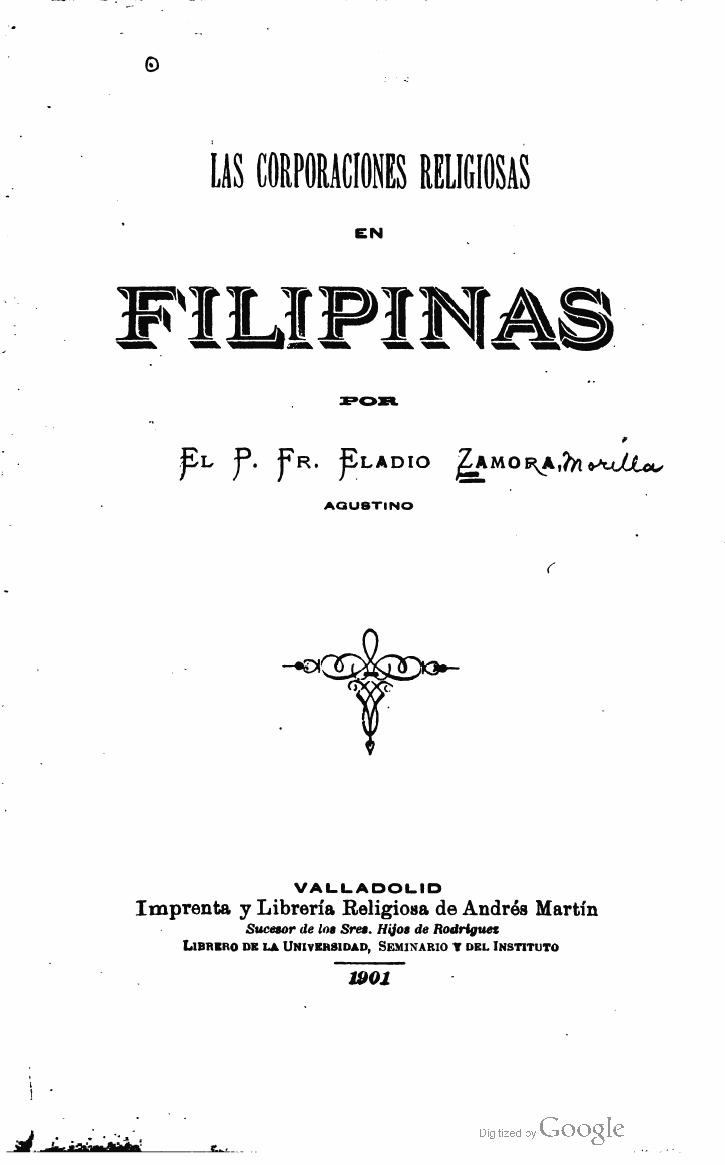 |
|
LAS CORPORACIONES RELIGIOSAS EN FILIPINAS Published 1901 in Valladolid, Spain Cabatuan is on pages 390, 392, 393; indicated by red arrows. |
 |
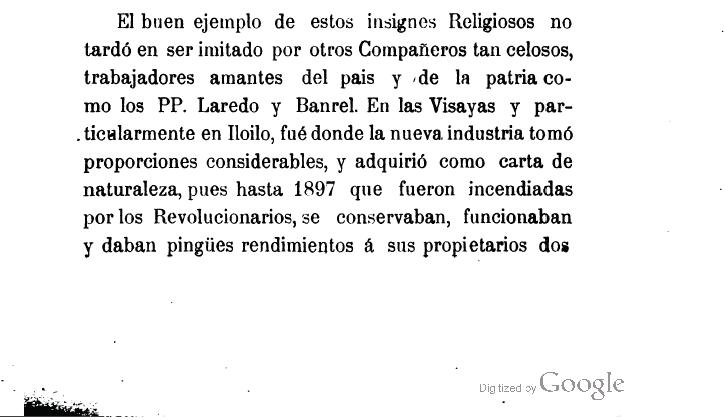 The good example of these religious insignia did not take long in being imitated by other so jealous Companions, working lovers of the country and the mother country like the PP. Laredo and Banrel. In the Visayas and particularly in Iloilo, it was where the new industry took considerable proportions, and acquired like naturalization paper, because until 1897 that were set afire by the Revolutionaries, they were conserved, they worked and they gave pingües yields to his proprietors two
The good example of these religious insignia did not take long in being imitated by other so jealous Companions, working lovers of the country and the mother country like the PP. Laredo and Banrel. In the Visayas and particularly in Iloilo, it was where the new industry took considerable proportions, and acquired like naturalization paper, because until 1897 that were set afire by the Revolutionaries, they were conserved, they worked and they gave pingües yields to his proprietors two
|
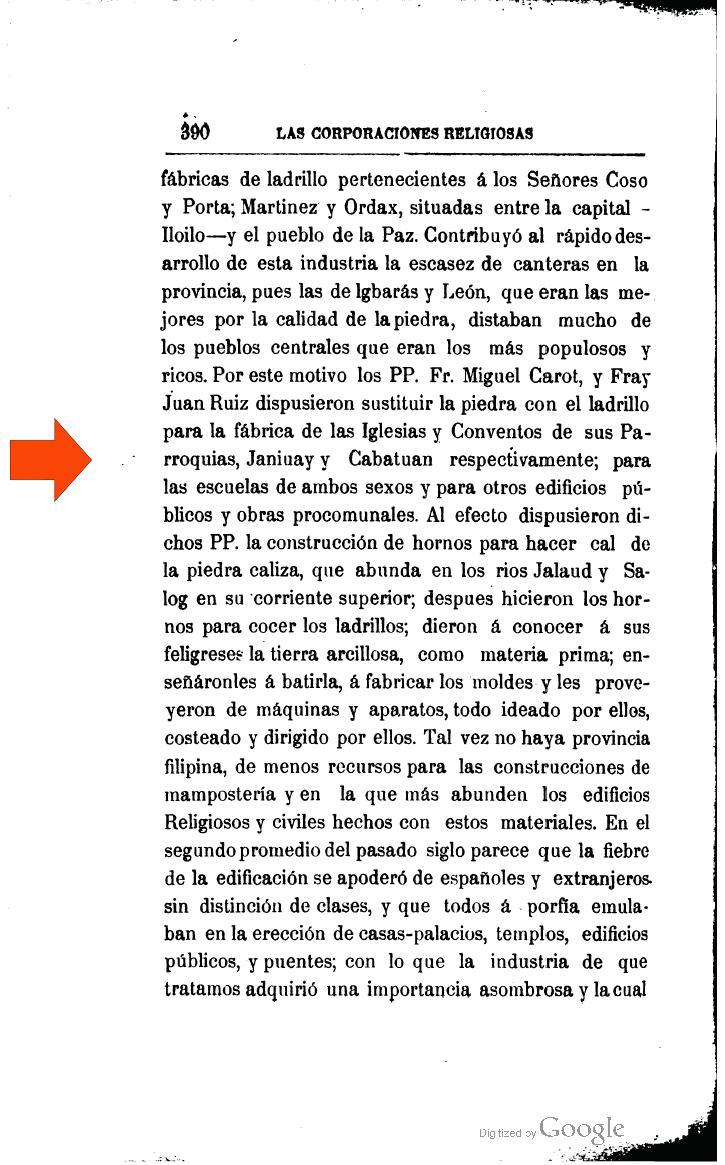
|
brick factories pertaining to the Señores Coso and Porta; Martinez and Ordax, located between the capital Iloilo and the town of La Paz. He contributed to the fast development of this industry the shortage of quarries in the province, because those of lgbarás and Leon, that were the best ones by the quality of the stone, they were much of the central towns that were most populated and rich. For this reason the PP. Fr. Miguel Carot, and Fray Juan Ruiz arranged to replace the stone with the brick to the factory of the Churches and Convents of their Parishes, Janiuay and Cabatnan respectively; for the schools of both sexes and other buildings procommunal public and works. AI effect arranged these PP. the construction of furnaces to make lime of the limestone stone, that abounds in the rivers Jalaud and Salog in its current superior; later they made the furnaces to cook bricks; they presented to its feligreses the argillaceous Earth, like raw material; enseñáronles to beat it, to make the molds and provided with machines and apparatuses to them, everything devised by them, paid for and directed by them. Perhaps there is no Philippine province, of less resources for the constructions of rubblework and in which the Religious buildings abound more and civil facts with these materials. In the second average of the past century it seems that the fever of the construction seized of Spaniards and foreigners without distinction of classes, and that all to porfía emulated in the erection of house-palaces, temples, buildings public, and bridges; and so the industry of which we tried acquired an amazing importance and which |
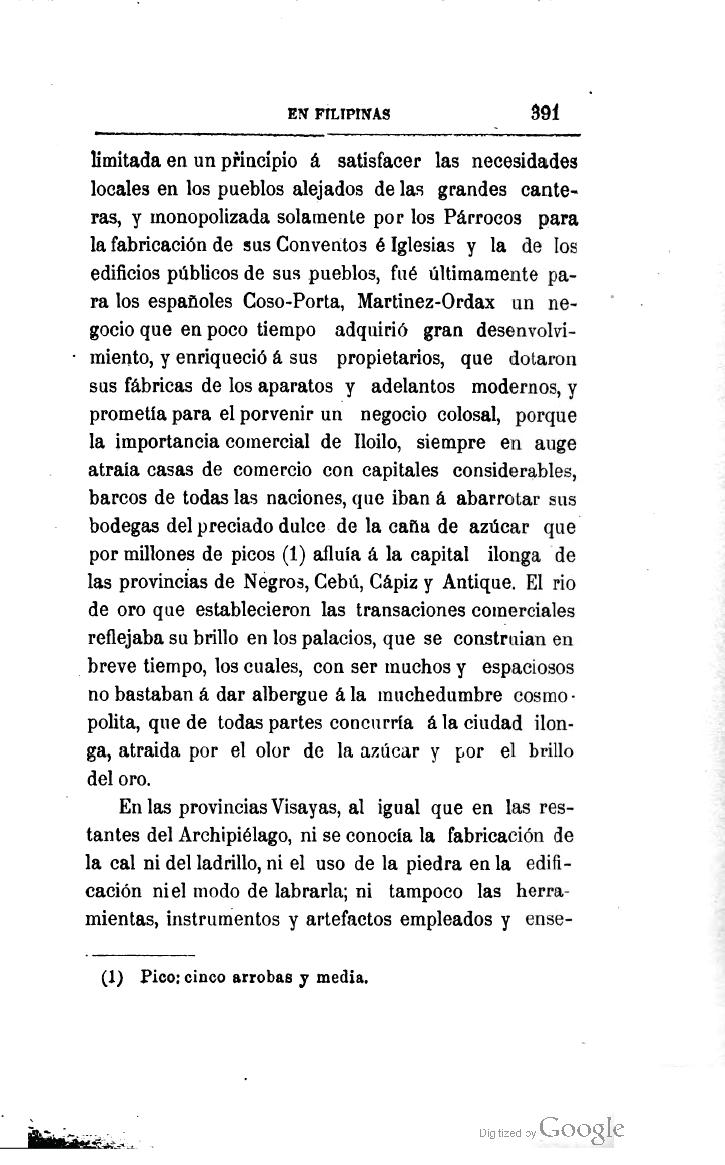
limited at first to satisfy the local needs in the moved away towns with the great quarries, and only monopolized by the Parish priests for the manufacture of its Convents and Churches and the one of the buildings public of its towns, it was lately for the Spaniards Sew-Carry, Martinez-Ordax a business that in just a short time acquired great unfolding, and enriched to its proprietors, which they equipped to its factories with the apparatuses and modern advances, and promised for the future a colossal business, because the commercial importance of Iloilo, always in height attracted houses of commerce with considerable capitals, boats of all the nations, that were going to jam their warehouses of the sweet appraised one of the cane of sugar that by million tips (1) flew to the capital ilonga of the provinces of Blacks, Zebu, Cápiz and Antique. The gold river that established the commercial transaciones reflected its brightness in the palaces, that were constructed time shortly, which, with being many and extensive were not enough to give shelter to the cosmopolitan crowd, is all parts concurred to the city ilonga, attracted by the scent of the sugar and the brightness of gold. In the Visayas provinces, like in the rest of the Archipelago, neither the manufacture of the lime nor the brick was known, nor the use of the stone in the construction nor the way to work it; nor were either tools, instruments and devices used and |
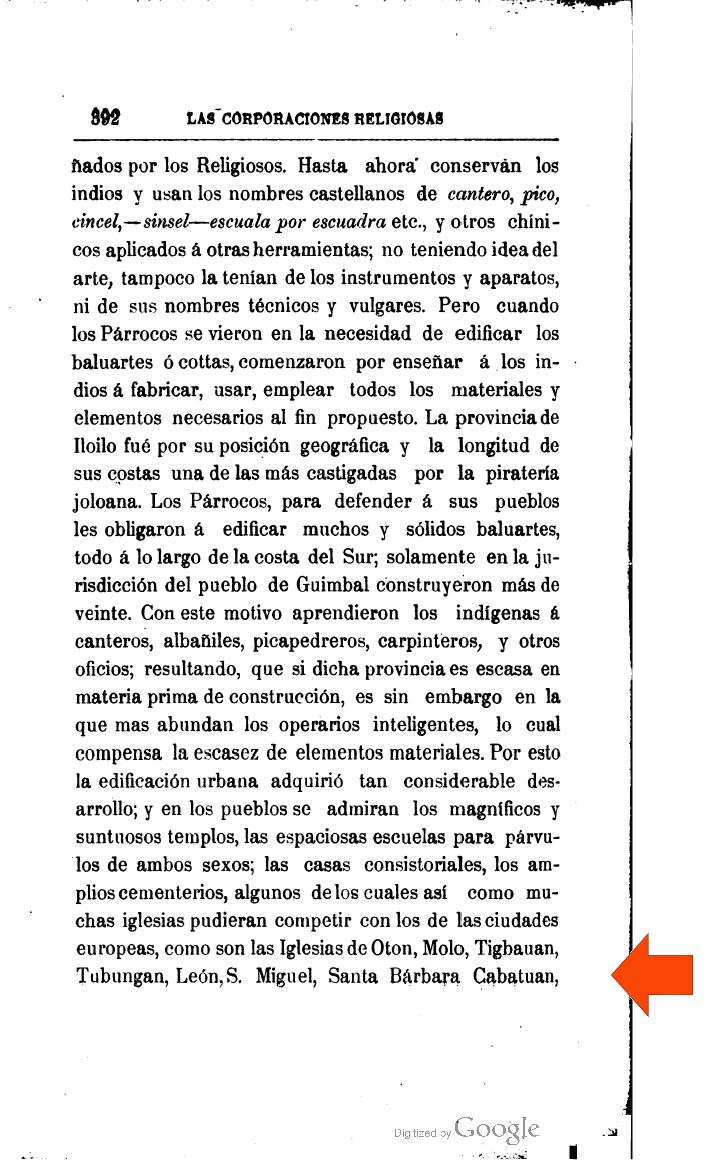
embossomed by the priests. Until now they conserve the Indians and uses” the Castilian names of stonecutter, tip, chisel, - sinsel-shark by square etc., and other chímeos applied to other tools; not having idea of the art, they did not have delos either instruments and apparatuses, nor of his technical and vulgar names. But when the Parish priests saw themselves in the necessity to build the bastions or cottas, they began to teach to the Indians to make, to use, to use all the necessary materials and elements to the proposed aim. The province of Iloilo was by its geographic position and the length of its coasts one of the most punished by the joloana piracy. The Parish priests, to defend to their towns forced to them to build many and solid bastions, everything throughout the coast of the South; only in the jurisdiction of the town of Guimbal they constructed more than twenty. With this reason the natives to stonecutters learned, bricklayers, stonemasons, carpenters, and other offices; being, that if this province is little in raw material of construction, is nevertheless in that mas' the intelligent workers abound, which compensates the shortage of material elements. By this the urban construction acquired so considerable development; and in the towns the magnificent and sumptuous temples, the extensive schools for párvulos of both sexes are admired; the consistorial houses, the ample cemeteries, some delos as as well as many churches could compete with those of the European cities, as they are the Churches of Oton, Molo, Tigbauan, Tubungan, Leon, S. Miguel, Santa Barbara, Cabatuan |
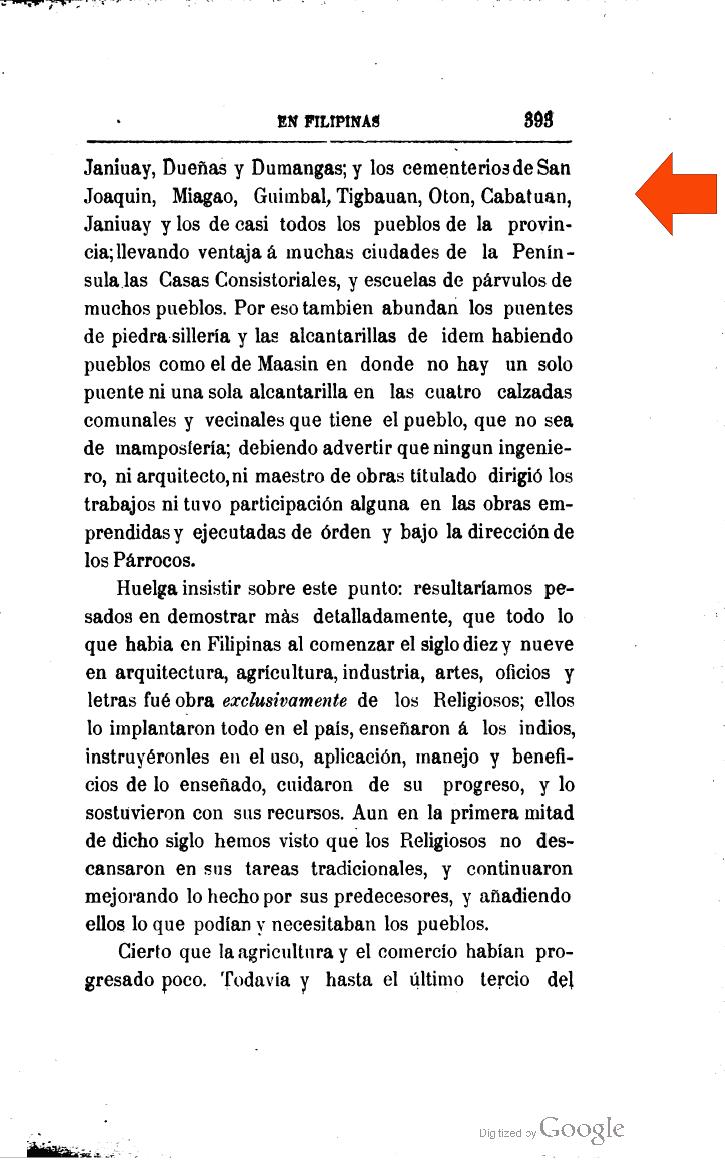
Janiuay, Dueñas and Dumangas; and the cemeteries of San Joaquin, Miagao, Guimbal, Tigbauan, Oton, Cabatuan, Janiuay and those of almost all the towns of the province; taking advantage to many cities of the Peninsula the Consistorial Houses, and schools of párvulos of many towns. For that reason also they abound, stone bridges ashlar masonry and the culverts of idem being towns like the one of Maasin where not one culvert in the four communal and ocal roads is no a single bridge that the town has, that is not of mamposíería; having to notice that no engineer, neither architect, nor construction foreman titled directed the works nor it had participation some in works undertaken and executed of order and under the direction of the Parish priests. Strike to insist on this point: we would be heavy in demonstrating more in detail, than everything what habia in the Philippines when beginning century ten and nine in architecture, agriculture, industry, arts, offices and letters was work exclusively of the Monks; they implanted everything in the country, taught to the Indians, instruyéronles in the use, application, handling and benefits of the taught thing, took care of of their progress, they maintained and it with its resources. In first half of this century we have even seen that the Pieligiosos did not rest in their traditional tasks, and continued improving the fact by their predecessors, and adding they what they could and they needed the towns. Certain that agriculture and the commerce had progressed little. Still and until the last third |
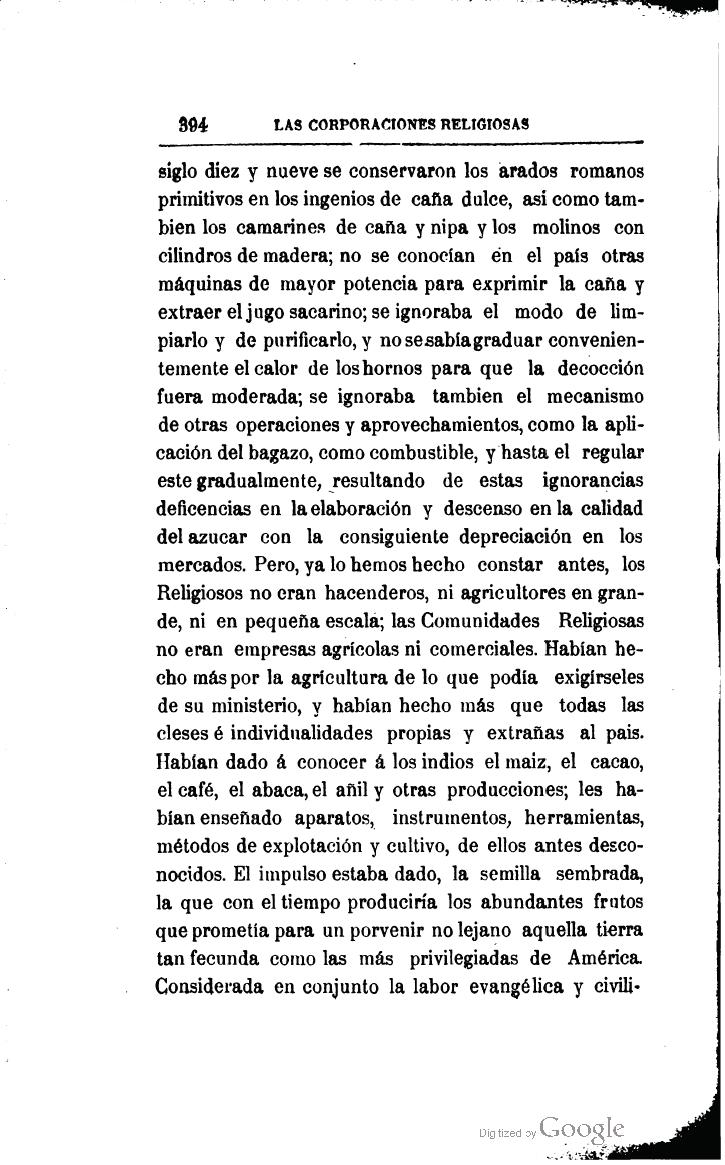
of the 19th century conserved the primitive Roman plows in the sweet cane talents, thus it eats also the cane dressing rooms and nipa and the mills with wood cylinders; other machines of greater power were not known in the country to express the cane and to extract the sacarino juice; the way was unknown to clean it and to purify it, and not to sabíagraduar properly the heat of the furnaces for (me the decoction was moderate; the mechanism of other operations and advantages was also unknown, like the application of the bagasse, fuel, and until regulating this gradually, being from these ignorance deficencias in the elaboration and reduction in the quality of sugar with consequent depreciation in the s markets. But, we have pointed out already it before, the Monks were not hacenderos, neither agriculturists in great, nor in small scale; the Religious Communities were not agricultural nor commercial companies. They had done more by agriculture than it could demand them of his ministry, and had done more than all the you laughed and own and strange individualities to the country. They had given; l to know to the Indians the corn, the cacao, the coffee, the manila, the indigo and other productions; they had taught apparatuses, instruments, tools, methods of operation and culture to them, them before unknown. The impulse was given, the seeded seed, the one that with time would produce the abundant fruits that one as fecund land as the most privileged of America promised for a nondistant future. Considered altogether the evangelical and civilizing work |
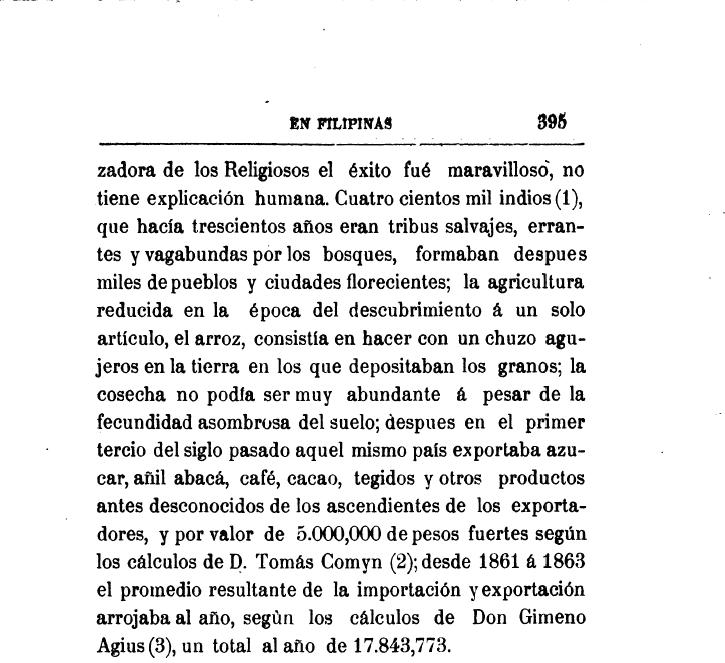
of the monks was a wonderful success, does not have human explanation. Four hundred thousand Indians (1), who three hundred years ago were wild tribes, nomadic and vagabond by the forests, later formed thousand of towns and flourishing cities; the agriculture reduced at the time of the discovery to a single article, the rice, consisted of making with chuzo Earth holes in which they deposited grains; the harvest could not be very abundant in spite of the amazing fecundity of the ground; later in the first third of the past century that one same country exported sugar, indigo manila, coffee, cacao, tegidos and other products before unknown of the parents of the exporter, and for 5,000, 000 of strong pesos according to the calculations of D. Comyn Takings (2); from 1861 to 1863 the resulting average of the import and export threw to the year, segün the calculations of Don Gimeno Agius (3), a total to the year of 17,843, 773. |